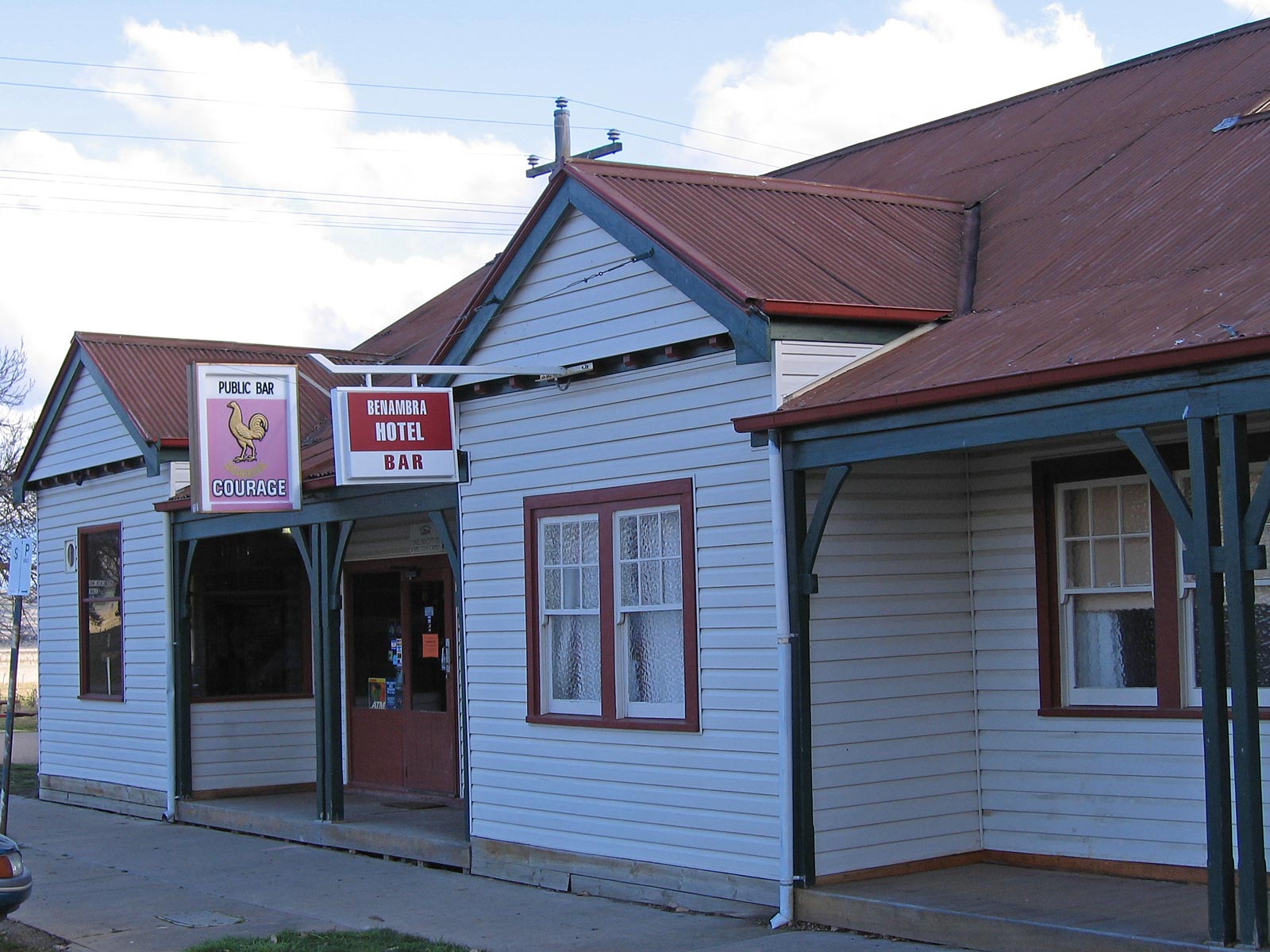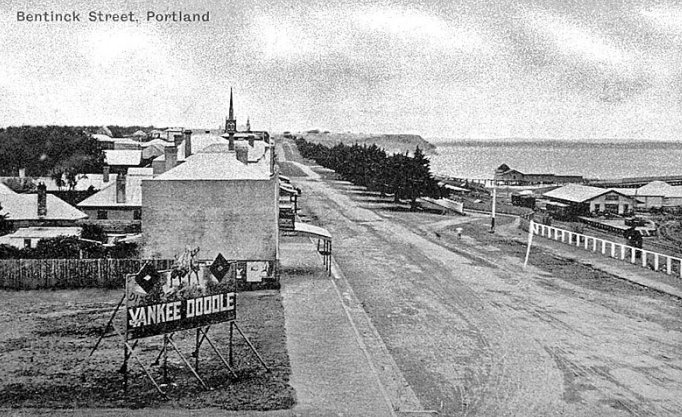|
Benambra
Benambra is a small town 28 kilometres (17 mi) north-east of Omeo and 430 kilometres (267 mi) east of the state capital Melbourne, in the Australian Alps of East Gippsland, Victoria, Australia. Nearby towns include Swifts Creek, Ensay, and the major town of Bairnsdale. At the 2016 census, Benambra and the surrounding area had a population of 149. The Town Benambra town centre is at the intersection of Gibbo Street and Limestone Road, at an altitude of approximately 700m. The town has a population of around 150, although most residents live on farms and properties out of the actual town. From its early days Benambra has been regarded as a premier agricultural area, specialising in both sheep and cattle farming. The annual weaner calf sales, held in March, attract buyers from across Australia who are seeking high quality predominantly Hereford and Hereford Shorthorn Cross calves on offer. Merino sheep are raised for wool, and there is a smal ... [...More Info...] [...Related Items...] OR: [Wikipedia] [Google] [Baidu] |
Omeo, Victoria
Omeo ( ) is a town in Victoria, Australia on the Great Alpine Road, east of Mount Hotham, in the Shire of East Gippsland. At the 2016 census, Omeo had a population of 406. The name is derived from an Aboriginal word for 'mountains' or 'hills'. Omeo is affectionately known as the City of the Alps with many historic buildings remaining in the town. The town is still the commercial hub for the Omeo Region and is a service centre for outlying communities such as Benambra, Cobungra, Cassilis, Swifts Creek, and Ensay. History The first reported sighting by Europeans of the wide plain that the Aborigines called 'Omeo' was by the naturalist John Lhotsky from the southern Alps in 1834. The area was first visited by stockmen who drove stock through the region as early as 1835. In 1845 gold was found in the Livingstone Creek which runs through Omeo, this caused the population to boom and by 1901, Omeo was at its peak with a population of 9400. They were prosperous times. The main ... [...More Info...] [...Related Items...] OR: [Wikipedia] [Google] [Baidu] |
Ensay, Victoria
Ensay is a small town located between Swifts Creek and Bruthen on the Great Alpine Road in East Gippsland, Victoria, Australia. Ensay is north of the major town of Bairnsdale and east of the state capital Melbourne. Other nearby towns include Omeo and Benambra. The town centre is located north of the confluence of the Little and Tambo river; with an altitude of approximately AMSL. The population of Ensay was 109 as at the 2016 census. History The Aboriginal name for the area around Ensay was ''Numblamunjie'', which translates as ‘blackfish place’. Archibald Macleod (see Bairnsdale, History) set up a station in this area in 1843. He named it after the now unpopulated island of Ensay in the Outer Hebrides of his homeland of Scotland, whose name originates from the Old Norse for Ewe Island. Scottish Parliament Place Names Reference The land around Ensay was originally taken up in 1839 by the noted explorer of the district Angus McMillan on behalf of his then employ ... [...More Info...] [...Related Items...] OR: [Wikipedia] [Google] [Baidu] |
Electoral District Of Gippsland East
The electoral district of Gippsland East is an electoral district of the Victorian Legislative Assembly. It covers most of eastern Victoria and includes the towns of Bairnsdale, Lakes Entrance, Orbost, Omeo, Maffra and Heyfield. Gippsland East is the state's third largest electorate in area and covers 27,544 square kilometres. The National Party held the seat without interruption from 1920 to 1999. However at the 1999 election independent candidate Craig Ingram unexpectedly won the seat after receiving preferences from the independent, One Nation and Labor candidates. Ingram's victory affected state politics—Ingram and fellow Independents Susan Davies and Russell Savage contributed to the end of the Kennett era by agreeing to back Labor to form government after the 1999 election. Ingram was also returned in the 2002 and 2006 elections. He was defeated in 2010 by National candidate Tim Bull Timothy Owen Bull (born 9 December 1966) is an Australian politician. He has be ... [...More Info...] [...Related Items...] OR: [Wikipedia] [Google] [Baidu] |
Trout
Trout are species of freshwater fish belonging to the genera '' Oncorhynchus'', ''Salmo'' and ''Salvelinus'', all of the subfamily Salmoninae of the family Salmonidae. The word ''trout'' is also used as part of the name of some non-salmonid fish such as ''Cynoscion nebulosus'', the spotted seatrout or speckled trout. Trout are closely related to salmon and char (or charr): species termed salmon and char occur in the same genera as do fish called trout (''Oncorhynchus'' – Pacific salmon and trout, ''Salmo'' – Atlantic salmon and various trout, ''Salvelinus'' – char and trout). Lake trout and most other trout live in freshwater lakes and rivers exclusively, while there are others, such as the steelhead, a form of the coastal rainbow trout, that can spend two or three years at sea before returning to fresh water to spawn (a habit more typical of salmon). Arctic char and brook trout are part of the char genus. Trout are an important food source for humans and wildlife, ... [...More Info...] [...Related Items...] OR: [Wikipedia] [Google] [Baidu] |
Sydney
Sydney ( ) is the capital city of the state of New South Wales, and the most populous city in both Australia and Oceania. Located on Australia's east coast, the metropolis surrounds Sydney Harbour and extends about towards the Blue Mountains to the west, Hawkesbury to the north, the Royal National Park to the south and Macarthur to the south-west. Sydney is made up of 658 suburbs, spread across 33 local government areas. Residents of the city are known as "Sydneysiders". The 2021 census recorded the population of Greater Sydney as 5,231,150, meaning the city is home to approximately 66% of the state's population. Estimated resident population, 30 June 2017. Nicknames of the city include the 'Emerald City' and the 'Harbour City'. Aboriginal Australians have inhabited the Greater Sydney region for at least 30,000 years, and Aboriginal engravings and cultural sites are common throughout Greater Sydney. The traditional custodians of the land on which modern Sydney stands are ... [...More Info...] [...Related Items...] OR: [Wikipedia] [Google] [Baidu] |
New South Wales
) , nickname = , image_map = New South Wales in Australia.svg , map_caption = Location of New South Wales in AustraliaCoordinates: , subdivision_type = Country , subdivision_name = Australia , established_title = Before federation , established_date = Colony of New South Wales , established_title2 = Establishment , established_date2 = 26 January 1788 , established_title3 = Responsible government , established_date3 = 6 June 1856 , established_title4 = Federation , established_date4 = 1 January 1901 , named_for = Wales , demonym = , capital = Sydney , largest_city = capital , coordinates = , admin_center = 128 local government areas , admin_center_type = Administration , leader_title1 = Monarch , leader_name1 = Charles III , leader_title2 = Governor , leader_name2 = Margaret Beazley , leader_title3 = Premier , leader_name3 = Dominic Perrottet (Liberal) , national_representation = Parliament of Australia , national_representation_type1 = Senat ... [...More Info...] [...Related Items...] OR: [Wikipedia] [Google] [Baidu] |
Monaro, New South Wales
Monaro ( ), once frequently spelled "Manaro", or in early years of settlement "Maneroo" is a region in the south of New South Wales, Australia. A small area of Victoria near Snowy River National Park is geographically part of the Monaro. While the Australian Capital Territory is not considered part of the region, some towns in the Monaro have close links with Canberra. The Snowy Monaro Regional Council was established in 2016 which comprises the former Bombala, Cooma-Monaro and Snowy River Local Government Areas. The area was traditionally inhabited by Ngarigo, Walgalu, Bidawal and Southern Ngunnawal people. It boasts of snowfields, expansive timber forests and the Snowy River. Holden's 'Monaro' Coupe (and later sedan) models ( 1967-1977, 2001-2006, 1973-1974 (Sedan)) were named after the area. Geography The Monaro region is a plateau area lying about 1000 metres above sea level, extending from the valley of the Murrumbidgee River in the north to the Errinundra Plateau in t ... [...More Info...] [...Related Items...] OR: [Wikipedia] [Google] [Baidu] |
Gunai People
The Gunaikurnai or Gunai/Kurnai ( ) people, also referred to as the Gunnai or Kurnai, are an Aboriginal Australian nation of south-east Australia. They are the Traditional Custodians of most of present-day Gippsland and much of the southern slopes of the Victorian Alps. The Gunaikurnai nation is composed of five major clans. Many of the Gunaikurnai people resisted early European squatting and subsequent settlement during the nineteenth century, resulting in a number of deadly confrontations between Europeans and the Gunaikurnai. There are about 3,000 Gunaikurnai people alive today, predominantly living in Gippsland. The Gunaikurnai dialects are the traditional language of the Gunaikurnai people, although there are very few fluent speakers today. Creation story It is told that the first Kurnai came down from the north west mountains, with his canoe on his head. He was known as Borun, the pelican. He crossed the Tribal River (where Sale now stands) and walked on into the west to ... [...More Info...] [...Related Items...] OR: [Wikipedia] [Google] [Baidu] |
Indigenous Australians
Indigenous Australians or Australian First Nations are people with familial heritage from, and membership in, the ethnic groups that lived in Australia before British colonisation. They consist of two distinct groups: the Aboriginal peoples of the Australian mainland and Tasmania, and the Torres Strait Islander peoples from the seas between Queensland and Papua New Guinea. The term Aboriginal and Torres Strait Islander peoples or the person's specific cultural group, is often preferred, though the terms First Nations of Australia, First Peoples of Australia and First Australians are also increasingly common; 812,728 people self-identified as being of Aboriginal and/or Torres Strait Islander origin in the 2021 Australian Census, representing 3.2% of the total population of Australia. Of these indigenous Australians, 91.4% identified as Aboriginal; 4.2% identified as Torres Strait Islander; while 4.4% identified with both groups. [...More Info...] [...Related Items...] OR: [Wikipedia] [Google] [Baidu] |
Portland, Victoria
Portland is a city in Victoria, Australia, and is the oldest European settlement in the state. It is also the main urban centre in the Shire of Glenelg and is located on Portland Bay. As of the 2021 census the population was 10,016, increasing from a population of 9,712 taken at the 2016 census. History Early history The Gunditjmara, an Aboriginal Australian people, are the traditional owners of much of south-west Victoria, including what is now Portland, having lived there for thousands of years. They are today renowned for their early aquaculture development at nearby Lake Condah. Physical remains such as the weirs and fish traps are to be found in the Budj Bim heritage areas. The Gunditjmara were a settled people, living in small circular weather-proof stone huts about high, grouped as villages, often around eel traps and aquaculture ponds. On just one hectare of Allambie Farm, archaeologists have discovered the remains of 160 house sites. 19th century European settlement ... [...More Info...] [...Related Items...] OR: [Wikipedia] [Google] [Baidu] |







